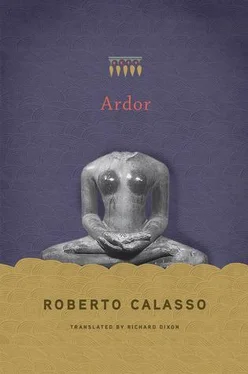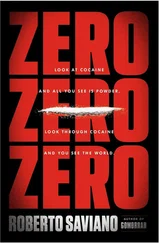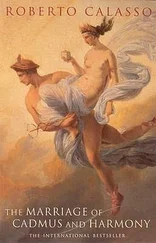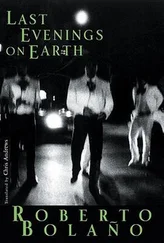It is easy to imagine from the story of Bhṛgu how the Vedic seers were skilled in detecting evil with supreme ease. Evil for them was already apparent at the moment when an axe first struck a tree or a hand uprooted a plant. It was metaphysical evil, inherent in everything that is forced to destroy a part of the world in order to survive, therefore above all in mankind. Compared with the moderns, who tend to limit evil to intentional acts, the Vedic seers had a conception of evil that covered a far wider area. And it included certain involuntary acts, as well as acts that just cannot be avoided if mankind wants to survive — for example, the act of eating. Evil is therefore everywhere and in everything. This explains why sacrifice is also everywhere and in everything. Sacrifice is the act by which evil is brought to consciousness, using an art learned from “he who knows thus.” That process in which evil is repeated and is directed, in its entirety, toward consciousness, through gestures and formulas, is the supreme remedy we can use in combating evil. Otherwise, all that remains is the mechanism revealed during Bhṛgu’s journey. Those who eat will be eaten. Those who slaughter will be slaughtered. Those who eat food will themselves become food.
The widespread atrocities, the endless and unrestrainable alternation between devourer and devoured, that Bhṛgu had encountered during his wanderings to the four corners of the world — and which his father, Varuṇa, taught him to overcome through the practice of sacrifice — never disappear, but indeed become threateningly apparent during the performance of the sacrifice itself. The sacrificial flames are like eyes, “they fix their attention on the sacrificer and focus on him.” What they would most desire is not the oblation, but the sacrificer himself. In front of the fire, the sacrificer feels he is being observed, stared at. The eye that is studying him is the eye of the fire. Before he himself formulates a desire, he feels it is the fire that desires him, his flesh. Here occurs the substitution, the redemption of Self: a last, swift operation to which the sacrificer resorts so as to offer the fire something instead of himself. The sacrificer offers food to avoid becoming food himself.
Bhṛgu encountered during his terrifying journey a world in which animals devoured people. But this wasn’t just a reversal of the order. It was also a lightning glimpse of the history of humanity, as if someone had at last taught Bhṛgu about some of his forebears. The period during which men, rather than devouring, were devoured is none other than the first, very long chapter of their history. Varuṇa wanted his son’s education to include this vision of the past, in the same way that a young boy might be sent to a good college to learn his country’s history. The Vedics were also this: they ignored history, more than any other people — but they remained in contact, more so than any other people, with remote prehistory, which showed through in their rites and in their myths.
* * *
In the Vedic landscape there is one object that evokes terror and veneration: the sacrificial post. Of all the emblems of that time, it is the only one still visible. In certain Indian villages, even today, a piece of wood can be seen sticking out of the ground, for no apparent reason. Madeleine Biardeau has found many of these in various parts of India, noting that they are that “post,” yūpa , the “thunderbolt” of which the Vedic ritualists spoke. But why a “thunderbolt”? To understand this, we have to go back to a distant story:
“There are an animal and a sacrificial post, for they never immolate an animal without a post. This is why: animals did not originally submit to the fact of becoming food, in the way that they have now become food. In the same way as man walks upright on two legs, they also walked upright on two legs.
“Then the gods noticed that thunderbolt, i.e., that sacrificial post; they put it in the ground and, for fear of it, the animals became crooked and four-legged, and so they became food, as today they are food, because they gave in: this is why they immolate the animal at the post, and never without a post.
“After having brought the victim forward and lit the fire, he ties the animal. This is why it is so: the animals did not originally submit to the fact of becoming sacrificial food, in the way that they have now become sacrificial food and are offered in the fire. The gods cage them: even caged in this way, they did not give in.
“They spoke: ‘In truth, these animals do not know how this happens, that sacrificial food is offered in the fire, and they do not know that safe place [the fire]: let us offer fire in fire after having fastened the animals and lit the fire, and they will know that this is how the sacrificial food is prepared, that this is its place; that it is in the fire itself that the sacrificial food is offered: and they will then yield and be favorably disposed to being immolated.’
“After having first fastened the animals and lit the fire, they offered fire in fire; and then they [the animals] knew that this is truly how the sacrificial food is prepared, that this is the place; that it is in the fire itself that the sacrificial food is offered. And as a result they yielded and were favorably disposed to being immolated.”
It would be very hard to find another text that describes with such great precision, with such great pathos, the decisive step that formalized the slaughter of domestic animals: the establishment of the meat diet. It was a necessity, but above all a guilty act, an act of enormous guilt. To justify its necessity, form was given to the theological edifice of the sacrifice, a temple-labyrinth, full of passages and tunnels, with countless junctures. And the sacrifice was needed to incorporate the guilt within it, indeed it would intensify and preserve it, as if in a casket. That guilt alluded to another, more deep-seated guilt, a consequence of which would be the sacrifice: the guilt of imitation , of that distant decision that had led a species of beings who had been prey to assume the behavior typical of their predator enemies. The first act against nature that would one day be seen as human nature itself — no other species would be so bold.
More than a “sick animal,” according to Hegel’s definition, man is an animal who essentially imitates (and imitation can also be seen as a human sickness). Man is the only being in the animal kingdom who has relinquished his nature, if by nature we mean that repertory of behavior with which every species appears to be equipped from birth. Strong, but not so strong that he didn’t have to recognize his own defenselessness in the face of other creatures — predators — man decided at a certain moment (which may also have lasted a hundred thousand years) not to fight against his adversaries but to imitate them. It was then that the being who had been prey taught himself to become a predator. He had teeth, not fangs — and his fingernails were not enough to rip into flesh. Nor did his body produce a poison, like snakes, who were formidable predators. He therefore had to resort to something no other predator had: the weapon, the instrument, the tool. This is how the flint and the arrow were created. At this point, through imitation and the production of tools, two important steps were taken — mimesis and technology — which the remainder of history would try to develop, up until today. Looking back, the upheaval produced by that first step — of mimesis, by which humans, of all creatures, decided to imitate precisely those who had so often killed them — is incomparably more radical and devastating than any subsequent step. A response to this upheaval was the sacrifice, in its many forms. Nothing else can explain why such uncharacteristic behavior, in comparison with anything else in the animal kingdom, occurred more or less everywhere, in a wide variety of forms but invariably sharing certain essential features. The sacrifice, before it assumed any other meaning, was a response to that immense upheaval within the species — and an attempt to redress a balance that had been upset and violated forever.
Читать дальше












